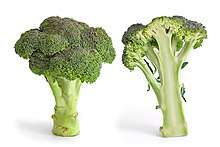Brassica oleracea
Brassica oleracea is a plant species that includes many common foods as cultivars, including cabbage, broccoli, cauliflower, kale, Brussels sprouts, collard greens, Savoy cabbage, kohlrabi, and gai lan.
| Brassica oleracea | |
|---|---|
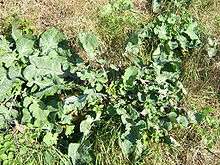 | |
| Wild cabbage plants | |
| Scientific classification | |
| Kingdom: | Plantae |
| Clade: | Tracheophytes |
| Clade: | Angiosperms |
| Clade: | Eudicots |
| Clade: | Rosids |
| Order: | Brassicales |
| Family: | Brassicaceae |
| Genus: | Brassica |
| Species: | B. oleracea |
| Binomial name | |
| Brassica oleracea | |
In its uncultivated form, it is called wild cabbage, and is native to coastal southern and western Europe. A hardy plant in its uncultivated form, its high tolerance for salt and lime, and its intolerance of competition from other plants, typically restrict its natural occurrence to limestone sea cliffs, like the chalk cliffs on both sides of the English Channel,[1] and the windswept coast on the western side of the Isle of Wight. Genetic analysis of nine wild population on the French Atlantic coast indicated their common feral origin, deriving from plants escaped from fields and gardens.[2]
Wild B. oleracea is a tall biennial plant that forms a stout rosette of large leaves in the first year. The leaves are fleshier and thicker than other Brassica species—an adaptation that helps it store water and nutrients in its difficult growing environment. In its second year, it uses the stored nutrients to produce a flower spike 1 to 2 metres (3–7 ft) tall with numerous yellow flowers.
Its specific epithet oleracea means "vegetable/herbal" in Latin and is a form of holeraceus (oleraceus).[3][4]
Cultivation and uses
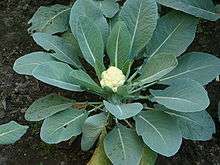
B. oleracea has become established as an important human food crop plant, used because of its large food reserves, which are stored over the winter in its leaves. It is rich in essential nutrients including vitamin C. A diet rich in cruciferous vegetables (e.g., cabbage, broccoli, cauliflower) is linked to a reduced risk of several human cancers.[5][6]
Researchers believe it has been cultivated for several thousand years, but its history as a domesticated plant is not clear before Greek and Roman times, when it was a well-established garden vegetable. Theophrastus mentions three kinds of rhaphanos (ῤάφανος):[7] a curly-leaved, a smooth-leaved, and a wild-type.[8] He reports the antipathy of the cabbage and the grape vine, for the ancients believed cabbages grown near grapes would impart their flavour to the wine.[9] It has been bred into a wide range of cultivars, including cabbage, broccoli, cauliflower, brussels sprouts, collards, and kale, some of which are hardly recognisable as being members of the same genus, let alone species. The historical genus of Crucifera, meaning "cross-bearing" in reference to the four-petaled flowers, may be the only unifying feature beyond taste.

Origins
According to the Triangle of U theory, B. oleracea is very closely related to five other species of the genus Brassica.[10]
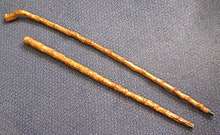
The cultivars of B. oleracea are grouped by developmental form into seven major cultivar groups, of which the Acephala ("non-heading") group remains most like the natural wild cabbage in appearance:
- Brassica oleracea Acephala group – kale and collard greens
- Brassica oleracea Alboglabra group – kai-lan (Chinese broccoli)
- Brassica oleracea Botrytis group – cauliflower, Romanesco broccoli, and broccoflower
- Brassica oleracea Capitata group – cabbage
- Brassica oleracea Gemmifera group – Brussels sprouts
- Brassica oleracea Gongylodes group – kohlrabi
- Brassica oleracea Italica group – broccoli
In places such as the Channel Islands and Canary Islands, where the frost is minimal and plants are thus freed from seasonality, some cultivars, known as Jersey cabbages, can grow up to 3 metres (9.8 ft) tall.[11] These "tree cabbages" yield fresh leaves throughout the year, are perennial, and do not need to be destroyed at harvest as with a normal cabbage. Their woody stalks are sometimes dried and made into walking sticks.[12][13]
History

With the advent of agriculture and the domestication of wild crop plants, the people of the northern Mediterranean began cultivating wild cabbage. Through artificial selection for various phenotype traits, the emergence of variations of the plant with drastic differences in looks took only a few thousand years. Preference for leaves, terminal bud, lateral bud, stem, and inflorescence resulted in selection of varieties of wild cabbage into the many forms known today.[14]
Impact of preference
- The preference for the eating of the leaves led to the selection of plants with larger leaves being harvested and their seeds planted for the next growth. Around the fifth century BC, the formation of what is now known as kale had developed.
- Preference led to further artificial selection of kale plants with more tightly bunched leaves, or terminal bud. Somewhere around the first century AD emerged the phenotype variation of B. oleracea known as cabbage.
- Phenotype selection preferences in Germany resulted in a new variation from the kale cultivar. By selecting for fatter stems, the variant plant known as kohlrabi emerged around the first century AD.
- European preference emerged for eating immature buds, selection for inflorescence. By the 15th century AD, cauliflower had developed, leading also to the emergence of broccoli in Italy about 100 years later.
- Further selection in Belgium in lateral bud led to Brussels sprouts in the 18th century.
Medicinal use
The Lumbee tribe of North Carolina has traditionally used the leaves of B. oleracea in medicine that they believed to have cleansing qualities, as well as a mild laxative, an anti-inflammatory, and treatment for glaucoma and pneumonia.

Genetics in relation to taste
The TAS2R38 gene encodes a G protein-coupled receptor that functions as a taste receptor, mediated by ligands such as PROP and phenylthiocarbamide that bind to the receptor and initiate signaling that confers various degrees of taste perception. Vegetables in the brassica family, such as collard greens, kale, broccoli, cabbage, and Brussels sprouts, contain glucosinolates and isothiocyanates, which resemble PROP, and therefore much of the perceived "bitterness" of these vegetables is mediated through TAS2R38. Bitter taste receptors in the TS2R family are also found in gut mucosal and pancreatic cells in humans and rodents. These receptors influence release of hormones involved in appetite regulation, such as peptide YY and glucagon-like peptide-1, and therefore may influence caloric intake and the development of obesity. Thus, bitter taste perception may affect dietary behaviors by influencing both taste preferences and metabolic hormonal regulation.[16]
Three variants in the TAS2R38 gene – rs713598, rs1726866, and rs10246939 – are in high linkage disequilibrium in most populations and result in amino acid coding changes that lead to a range of bitter taste perception phenotypes. The PAV haplotype is dominant; therefore, individuals with at least one copy of the PAV allele perceive molecules in vegetables that resemble PROP as tasting bitter, and consequently may develop an aversion to bitter vegetables. In contrast, individuals with two AVI haplotypes are bitter non-tasters. PAV and AVI haplotypes are the most common, though other haplotypes exist that confer intermediate bitter taste sensitivity (AAI, AAV, AVV, and PVI). This taste aversion may apply to vegetables in general.[16][17]
Cultivars
| Cultivar | Image | Name |
|---|---|---|
| Wild cabbage |  | Brassica oleracea var. oleracea |
| Cabbage |  | Brassica oleracea var. capitata f. alba |
| Savoy cabbage | 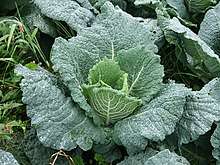 | Brassica oleracea var. capitata f. sabauda |
| Red cabbage | Brassica oleracea var. capitata f. rubra | |
| Cone cabbage | .jpg) | Brassica oleracea var. capitata f. acuta |
| Gai lan | 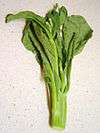 | Brassica oleracea var. alboglabra |
| Collard greens |  | Brassica oleracea var. viridis |
| Jersey cabbage |  | Brassica oleracea var. longata |
| Ornamental kale |  | Brassica oleracea var. acephala |
| Kale |  | Brassica oleracea var. sabellica |
| Kalette | 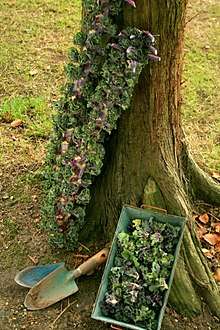 | Brassica oleracea var. viridis x gemmifera |
| Lacinato kale |  | Brassica oleracea var. palmifolia |
| Perpetual kale | Brassica oleracea var. ramosa | |
| Marrow cabbage |  | Brassica oleracea var. medullosa |
| Tronchuda kale | Brassica oleracea var. costata | |
| Brussels sprout | _(2).jpg) | Brassica oleracea var. gemmifera |
| Kohlrabi | .jpg) | Brassica oleracea var. gongylodes |
| Broccoli |  | Brassica oleracea var. italica |
| Cauliflower |  | Brassica oleracea var. botrytis |
| Caulini | 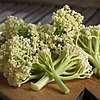 | Brassica oleracea |
| Romanesco broccoli |  | Brassica oleracea var. botrytis |
| Broccoli di Torbole | 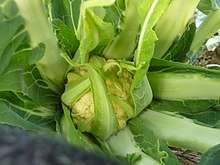 | Brassica oleracea var. botrytis |
| Broccoflower | Brassica oleracea var. botrytis x italica | |
| Broccolini | 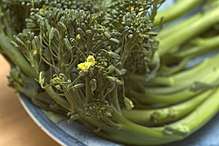 | Brassica oleracea var. italica × alboglabra |
References
- Snogerup, Sven; Gustafsson, Mats; Bothmer, Roland Von (1990-01-01). "Brassica sect. Brassica (Brassicaceae) I. Taxonomy and Variation". Willdenowia. 19 (2): 271–365. JSTOR 3996645.
- Maggioni, Lorenzo; von Bothmer, Roland; Poulsen, Gert; Härnström Aloisi, Karolina (2020). "Survey and genetic diversity of wild Brassica oleracea L. Germplasm on the Atlantic coast of France". Genetic Resources and Crop Evolution. doi:10.1007/s10722-020-00945-0. S2CID 218772995.
- Parker, Peter (2018). A Little Book of Latin for Gardeners. Little Brown Book Group. p. 328. ISBN 978-1-4087-0615-2.
oleraceus, holeraceus = relating to vegetables or kitchen garden
- Whitney, William Dwight (1899). The Century Dictionary and Cyclopedia. Century Co. p. 2856.
L. holeraceus, prop. oleraceus, herb-like, holus, prop. olus (oler-), herbs, vegetables
- Verhoeven, D. T.; Goldbohm, R. A.; van Poppel, G.; Verhagen, H.; van den Brandt, P. A. (1996-09-01). "Epidemiological studies on brassica vegetables and cancer risk". Cancer Epidemiology, Biomarkers & Prevention. 5 (9): 733–748. ISSN 1055-9965. PMID 8877066.
- Higdon, Jane V.; Delage, Barbara; Williams, David E.; Dashwood, Roderick H. (2007-03-01). "Cruciferous vegetables and human cancer risk: epidemiologic evidence and mechanistic basis". Pharmacological Research. 55 (3): 224–236. doi:10.1016/j.phrs.2007.01.009. ISSN 1043-6618. PMC 2737735. PMID 17317210.
- Compare Theophrastus; raphanis (ραφανίς), "radish", also a Brassica.
- Zohary, Daniel; Hopf, Maria; Weiss, Ehud (2012). Domestication of Plants in the Old World: The Origin and Spread of Domesticated Plants in Southwest Asia, Europe, and the Mediterranean Basin. OUP Oxford. p. 199. ISBN 978-0199549061.
- Theophrastus, Enquiry into Plants, IV.6.16; Deipnosophistae, I, noting the effects of cabbages on wine and wine-drinkers, also quotes Apollodorus of Carystus: "If they think that our calling it a rhaphanos, while you foreigners call it a krambê, makes any difference to us women!" (on-line English text).
- Dixon, G.R. (2007). Vegetable brassicas and related crucifers. Wallingford: CABI. ISBN 978-0-85199-395-9.
- Miller, Philip (1835). The Gardeners Dictionary. Volume 1 (9th ed.). p. 208.
- Ayto, John (2012). The Diner's Dictionary: Word Origins of Food and Drink. Oxford University Press. p. 187. ISBN 9780199640249.
- Williams, Paul H.; Hill, Curtis B. (June 13, 1986). "Rapid-Cycling Populations of Brassica" (PDF). Science. New Series. 232 (4756): 1385–1389. Bibcode:1986Sci...232.1385W. doi:10.1126/science.232.4756.1385. PMID 17828914. S2CID 25779465.
- Osnas, Jeanne L. D. (2012-11-05). "The extraordinary diversity of Brassica oleracea". The Botanist in the Kitchen. Retrieved 2016-04-07.
- "Vegetables - University of Saskatchewan". agbio.usask.ca. Archived from the original on 2016-03-29. Retrieved 2016-04-07.
- Calancie, Larissa; Keyserling, Thomas C.; Smith-Taillie, Lindsey; Robasky, Kimberly; Patterson, Cam; Ammerman, Alice S.; Schisler, Jonathan C. (2018). "TAS2R38 predisposition to bitter taste associated with differential changes in vegetable intake in response to a community-based dietary intervention". G3: Genes | Genomes | Genetics. 8 (6): 2107–2119. doi:10.1534/g3.118.300547. PMC 5982837. PMID 29686110.

- Behrens, Maik; Gunn, Howard; Ramos, Purita (2013). "Genetic, Functional, and Phenotypic Diversity in TAS2R38-Mediated Bitter Taste Perception". Chemical Senses. 38 (6): 475–84. doi:10.1093/chemse/bjt016. PMID 23632915.
- Beckett, Emma (2014). "Bitter Taste Genetics – the Relationship to Tasting, Liking, Consumption and Health". Food Funct. 5 (12): 3040–54. doi:10.1039/C4FO00539B. PMID 25286017.
- Boxer, E.E.; Garneau, N.L. (2015). "Rare haplotypes of the gene TAS2R38 confer bitter taste sensitivity in humans". SpringerPlus. 4: 505. doi:10.1186/s40064-015-1277-z. PMC 4574037. PMID 26405625.
- Bufe, B. (2005). "The Molecular Basis of Individual Differences in Phenylthiocarbamide and Propylthiouracil Bitterness Perception". Curr. Biol. 15 (4): 322–7. doi:10.1016/j.cub.2005.01.047. PMC 1400547. PMID 15723792.</ref>
- Calancie, Larissa; et al. (2018). "TAS2R38 Predisposition to Bitter Taste Associated with Differential Changes in Vegetable Intake in Response to a Community-Based Dietary Intervention". G3: Genes|Genomes|Genetics. 8 (6): 2107–2119. doi:10.1534/g3.118.300547. PMC 5982837. PMID 29686110.
- Duffy, V.B.; et al. (2010). "Vegetable Intake in College-Aged Adults Is Explained by Oral Sensory Phenotypes and TAS2R38 Genotype". Chemosens. 3 (3–4): 137–148. doi:10.1007/s12078-010-9079-8. PMC 3000691. PMID 21157576.
- Wieczorek, Martyna.; et al. (2018). "Bitter Taste of Brassica Vegetables: The Role of Genetic Factors, Receptors, Isothiocyanates, Glucosinolates, and Flavor Context". Critical Reviews in Food Science and Nutrition. 58 (18): 3130–3140. doi:10.1080/10408398.2017.1353478. PMID 28718657. S2CID 28896102.
- Rozengurt, E. "Taste Receptors in the Gastrointestinal Tract. I. Bitter taste receptors and α-gustducin in the mammalian gut". Am. J. Physiol. Gastrointest. Liver Physiol. 7: 171–177.
- Roura, Eugeni; et al. (21 May 2015). "Variability in Human Bitter Taste Sensitivity to Chemically Diverse Compounds Can Be Accounted for by Differential TAS2R Activation". Chemical Senses. 40 (6): 427–35. doi:10.1093/chemse/bjv024. PMID 25999325.
- Risso, David; et al. (27 June 2016). "Erratum: Corrigendum: Global Diversity in the TAS2R38 Bitter Taste Receptor: Revisiting a Classic Evolutionary PROPosal". Scientific Reports. 6.
- Mennella, Vito; et al. (20 February 2005). "Functionally Distinct Kinesin-13 Family Members Cooperate to Regulate Microtubule Dynamics during Interphase". Nature Cell Biology. 7 (3): 235–45. doi:10.1038/ncb1222. PMID 15723056. S2CID 6501199.
- Kim, U.K.; et al. (2005). "Genetics of individual differences in bitter taste perception: lessons from the PTC gene". Clin. Genet. 67 (4): 275–80. doi:10.1111/j.1399-0004.2004.00361.x. PMID 15733260.
- Kim, U.K.; et al. (2004). "Genetics of Human Taste Perception". J. Dent. Res. 83 (6): 448–53. doi:10.1177/154405910408300603. PMID 15153450. S2CID 8801457.
- Khataan, Nora H.; et al. (2009). "TAS2R38 Genotypes and Phenylthiocarbamide Bitter Taste Perception in a Population of Young Adults". Journal of Nutrigenetics and Nutrigenomics. 2 (4–5): 251–6. doi:10.1159/000297217. PMID 20484932. S2CID 45496712.
- Genick, U.K.; et al. (2011). "Sensitivity of genome-wide-association signals to phenotyping strategy: the PROP-TAS2R38 taste association as a benchmark". PLOS ONE. 6 (11): e27745. Bibcode:2011PLoSO...627745G. doi:10.1371/journal.pone.0027745. PMC 3223210. PMID 22132133.</ref>
External links
| Wikimedia Commons has media related to Brassica oleracea. |
